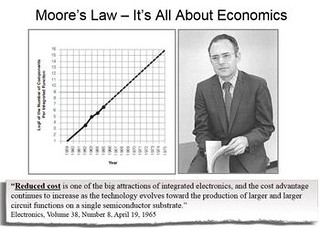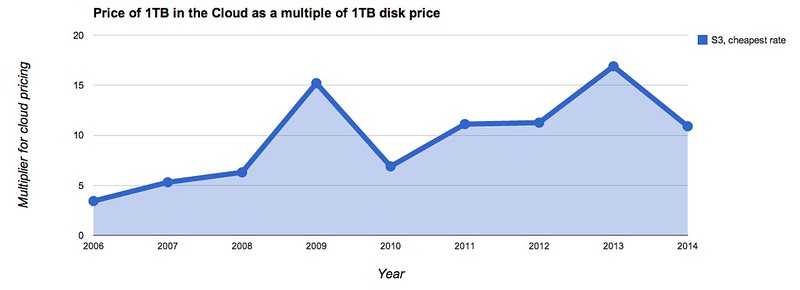R29vZ2xlIFNheXMgQ2xvdWQgUHJpY2VzIFdpbGwgRm9sbG93IE1vb3Jl4oCZcyBMYXc6IEFyZSBX ZSBBbGwgUmVudGVycyBOb3c/

After Google cut prices on their Google Cloud Platform Amazon quickly followed with their own price cuts. Even more interesting is what the future holds for pricing. The near future looks great. After that? We'll see.
Adrian Cockcroft highlights that Google thinks prices should follow Moore’s law, which means we should expect prices to halve every 18-24 months.
That's good news. Greater cost certainty means you can make much more aggressive build out plans. With the savings you can hire more people, handle more customers, and add those media rich features you thought you couldn't afford. Design is directly related to costs.
Without Google competing with Amazon there's little doubt the price reduction curve would be much less favorable.
As a late cloud entrant Google is now in a customer acquisition phase, so they are willing to pay for customers, which means lower prices are an acceptable cost of doing business. Profit and high margins are not the objective. Getting market share is what is important.
Amazon on the other hand has been reaping the higher margins earned from recurring customers. So Google's entrance into the early product life cycle phase is making Amazon eat into their margins and is forcing down prices over all.
But there's a floor to how low prices can go. Alen Peacock, co-founder of Space Monkey has an interesting graphic telling the story. This is Amazon's historical pricing for 1TB of storage in S3, graphed as a multiple of the historical pricing for 1TB of local hard disk:

Alen explains it this way:
The economic advantages of building your own (but housed in datacenters) is there, but it isn't huge. There is also some long term strategic advantage to building your own, e.g., GDrive dropped their price dramatically at will because Google owns their datacenters, but Dropbox couldn't do that without convincing Amazon to drop the price they pay for S3.
Costs other than hardware began dominating in datacenters several years ago, Moore's Law-like effects are dampened. Energy/cooling and cooling costs do not follow Moore's Law, and those costs make up a huge component of the overall picture in datacenters. This is only going to get worse, barring some radical new energy production technology arriving on the scene.
What we're [Space Monkey] interested in, long term, is dropping the floor out from underneath all of these, and I think that only happens if you get out of the datacenter entirely.
As the size of cloud market is still growing there will still be a fight for market share. When growth slows and the market is divided between major players a collusionary pricing phase will take over. Cloud customers are sticky customers. It's hard to move off a cloud. The need for higher margins to justify the cash flow drain during the customer acquisition phase will reverse the favorable trends we are seeing now.
Until then it seems the economics indicate we are in a rent, not a buy world.
Related Articles
- IaaS Series: Cloud Storage Pricing – How Low Can They Go? - "For now it seems we can assume we’ve not seen the last of the big price reductions."
- The Cloud Is Not Green
- Brad Stone: “Bill Miller, the chief investment officer at Legg Mason Capital Management and a major Amazon shareholder, asked Bezos at the time about the profitability prospects for AWS. Bezos predicted they would be good over the long term but said that he didn’t want to repeat “Steve Jobs’s mistake” of pricing the iPhone in a way that was so fantastically profitable that the smartphone market became a magnet for competition.”




